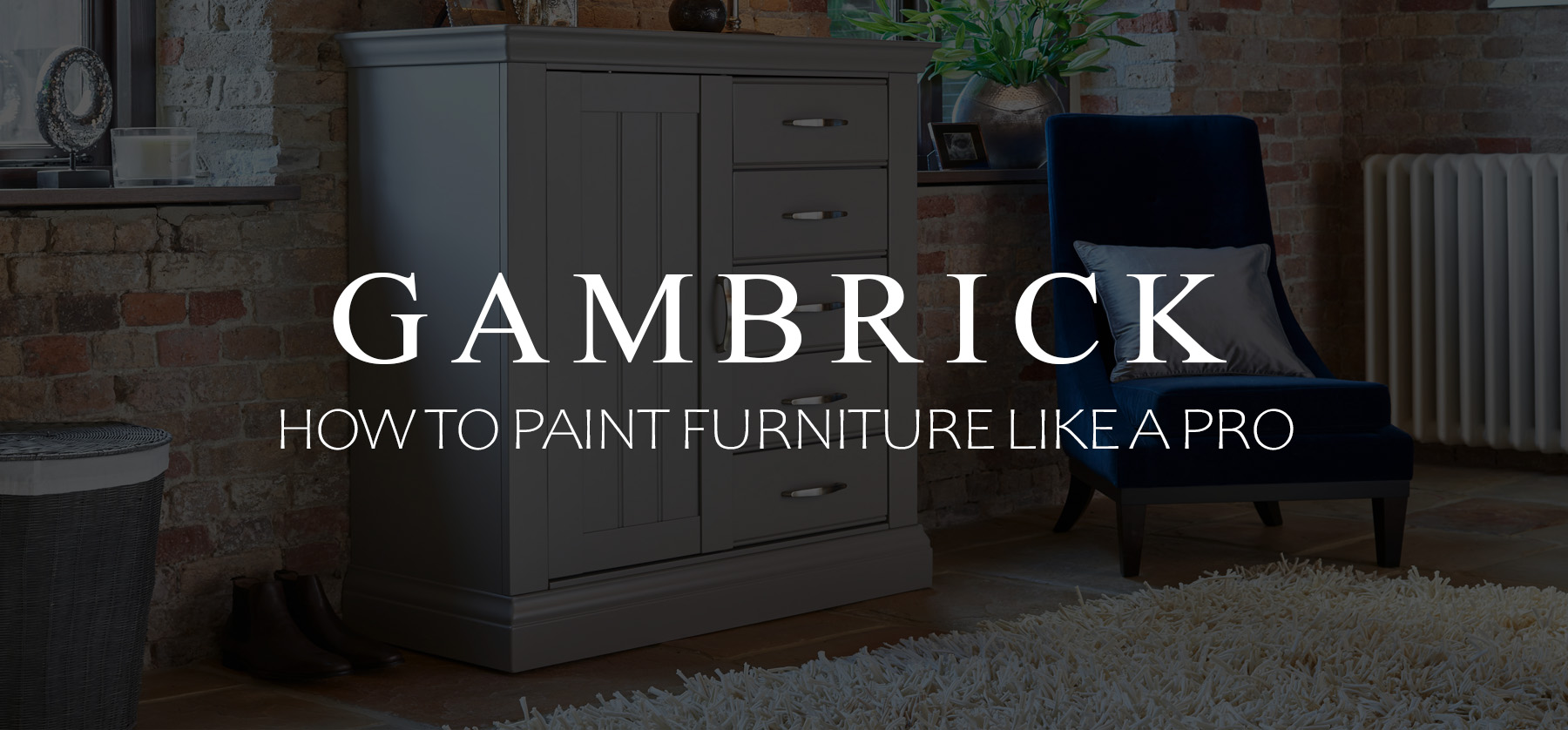How To Paint Furniture Like A Pro
Almost everyone has some experience painting walls and trim, but painting furniture is a little different. Especially if you want it to look like a factory finish. Did you know that almost all furniture that’s colored is painted at the factory. It’s generally sprayed on but it’s just regular paint and primer. They’re not doing anything special that you can’t re-produce at home if you know how. Painting furniture yourself is easy to do and can have excellent results. Even when the furniture is old and damaged. Preparation of the surface is key so get a good sanding pad and some fillers. A smooth and unpainted surface is best. Then you’ll need a good quality sandable primer. A satin or semigloss sheen and either a latex or oil based paint is best for furniture. And always make sure the primer you choose works with the paint.
Tarps, rags, mixing sticks, tape, brushes, rollers and a paint sprayer are all the general tools of the trade. I like to use a spray gun if I’m going for a smooth factory finish. But if I want texture or an antique look a brush and roller work better. The key to great looking painted furniture is prep. Make sure any damage is repaired and old finishes are removed. Especially clear coats because new paint may not stick properly.
At Gambrick we make custom cabinetry, built ins and other furniture pieces so I have lots of experience painting my own furniture. We also do a lot of restoration work which has all sorts of additional challenges. Ahead I’ll go over the basic process we use to paint furniture along with lots of Pro tips and tricks we use almost every day.
Painted Furniture Is Very In Style
Spend any time looking through online picture galleries of some of the finest homes, we’ve even got a bunch on this website, and you’ll see lots of painted furniture. Modern, Contemporary, Colonial, Traditional, Victorian or the super trendy Modern farmhouse. One thing they all have in common is painted furniture.
And that’s true in just about every room. Most cabinets and vanities you see these days are painted. And so are most tables, chairs, cribs and dressers. Even most built ins you see are painted white. It’s a style that’s been around for decades and it’s not going away.
The great thing about painting furniture is how versatile the look is. As a designer, if I’ve got a simple flat faced cabinet painted some light neutral color, I can use it in just about any home I’m working on. Painted furniture truly is one of the easiest things to work into a design. The only thing you have to do is pick the right color.
Prepare The Furniture For Paint
If you want your painted furniture to look professional, the most important thing is preparation. Most amateurs focus on the painting, but Pros are more concerned with prep. Painting is actually the fun and easy part. It’s all the repairs, sanding and priming that take time.
There’s just no way around it, some amount of sanding will almost always have to be done. In my entire entire career painting cabinets, built ins, and furniture I’ve had to sand just about every time. And in the rare cases when I didn’t, it was thanks to someone else doing the prep work for me.
The furniture’s surface has to be made ready for paint. It should be sanded smooth and free of any damage. If your painting over old paint make sure you remove the clear coat. New paint will generally stick to old, but not a clear coat. Also make sure you clean off any dust left on the furniture after sanding. Dust will also interfere with the paint.
Make sure any dents, gauges and damage are fully repaired before painting. Generally fillers need to be sanded down too.
Apply a layer of sandable primer prior to painting. This will also have to be sanded smooth with a fine grit paper before painting.
After all the hard work is done you’ll eventually get to start painting. But don’t skip the prep work. They’re essential if you want professional looking painted furniture.
How To Sand Furniture For Paint
You may have read some furniture painting tutorials that claim you don’t need to sand. And there are lots of primers and paints that say no sanding needed. But in my experience, sanding is a must if you want a professional finish. They do it at the factory so why not sand your furniture at home.
Be sure to start out with around a 150 grit sandpaper. Always start rough and then work down to a fine grit. But don’t use something so rough that you scratch the surface. You want to sand down to a smooth finish not gauge into the surface. If you see sand lines then the grit is too hard. I like to sand in long even strokes over the entire surface. And I never spot sand only a small area. Sanding reduces the surface area a little so you want that reduction to be even.
It’s possible to over sand an area which can actually cause a dip in the surface. That’s why sanding has to be done evenly. Furniture generally has flat surfaces. To maintain that flat surface you have to sand everything down evenly. When you only sand a small spot that area will get lower than the rest. And then you’ll have to build up the dip with filler. Sanding blocks or a power sander are great for keeping the sanding even.
Be careful not to gouge the surface with a power sander. Remember, your just trying to remove old paint, clear coats, primer or filler. Not alter the surface of the furniture. Go lightly.
Sanding Is Dusty
When your sanding furniture for paint it’s gonna get a little dusty. Make sure you tarp off ares where you don’t want the dust because it’ll get everywhere. Sawdust from sanding wood isn’t so bad. But the fine dust from sanded primer and filler gets everything.
I like to set up a prep and painting station in the garage. It’s easy to keep dust out of the house because the exterior doors have a bottom seal. Keep the windows and doors open if you can and wear a mask. It’s not good to breath in all that fine dust.
Make sure you wipe the furniture down with a soft damp rag when your done. The dust will interfere with how the paint sticks. And if it gets into the surface layer of the paint you’ll be able to feel it.
A trick I use when I can’t avoid sanding inside is to use a damp sanding sponge. They do the job and create less dust because the moisture absorbs it. I also keep a vacuum on hand to clean up as soon as I sand. Dust will get on your hands and sometimes your clothes and shoes so clean off before leaving the tarp.
Tarp Everything
If your painting furniture inside, make sure to tarp off everything. Put a big tarp on the floor and another over things you don’t want getting dirty. I can’t tell you how many people I know that painted furniture inside and got dust and paint everywhere. It’s easy to do, especially when your painting a large piece.
Watch your shoes as you step off the floor tarp. It’s so easy to track dust or paint around the house with your shoes. Vacuum your hands and clothing before leaving the tarp. Don’t dust yourself off because that will just kick dust into the air. Use a vacuum or damp cloth instead.
Wear a mask and crack a window if your painting furniture inside.
Take The Furniture Apart Before You Paint
It’s not always possible to do because some furniture is glued when assembled. But if you can, take the furniture apart before you paint. When furniture is factory painted, it’s done in parts and then assembled later. Reproducing these steps gives you the best possible finish. It’s just like painting a car. Cars are painted in parts and then assembled later because once you put them together it’s much harder to paint all the smaller pieces. And some angles are impossible to get to once assembled.
Another benefit to disassembly is preventing pooled paint. When you chalk paint furniture, there are usually small gaps where different parts come together. If you paint furniture all at once, some paint will pool in these tiny gaps. But when you take the furniture apart before you paint, you get a much cleaner edge and a clean separation between the parts.
Take out all the drawers and doors too. Cabinet doors are easy to unscrew at the hinges and doors just pull out. Also take off any hardware and all the knobs. The more disassembly you can do the better your paint job will look.
Disassembly is even more important when your using more than one color or different mediums. For example, white legs with a stained wood table is a very common look. Taking the furniture apart lets you stain and paint separately which make it easier to achieve the look.
Use Quality Sandable Primer
It’s always tempting to cut a few corners and get right to painting but take your time with the prep. Make sure to use a good quality sandable primer. Prime everything that needs painting and sand it smooth. When primer is applied it’s easier to spot small imperfections which can then be repaired.
Primer actually adds a very thin layer onto the surface of your furniture. Paint does too. Once the primer is applied and fully dried, inspect the furniture by eye and by touch. Run your fingers across the surface and feel for imperfections. I learned this trick from a great auto body man that fixed antique cars. You can sometimes feel an issue that you can’t see.
If you find a problem, stop and repair it. Use some filler and then sand it down. Prime over the repair and then sand and inspect again. It’s a tedious process but worth it if you want a great paint job.
Once I’m at the point where I don’t find any issues, I sand all the primer with a damp sanding sponge. This gets the surface smooth like glass. Finally I clean up and primer dust from the furniture.
Avoid cheap primers. When you sand them they clump instead of turning to dust.
Use Samples Or Returned Cans
It doesn’t take much paint to paint a chair or small dresser. Measure out the square footage of the furniture your painting and then check the can. In some cases you don’t need a full gallon. I always buy more than I need just in case but if your on a budget but just enough.
Another cost saving tip is to buy returned cans. When a gallon of paint is returned or damaged, paint stores will discount and sell it for practically nothing. I’ve seen good quality paint for $1 a gallon. You can’t choose your own color but if the colors right then why not save some money.
Another trick I’ve learned is that you can alter these cheap returned gallons. Buy a very light color and then tint it as needed. The returned paint essentially becomes a base color that you alter as needed. That’s why light colors work best. But any color will do if it’s close to the final color you want.
Make sure to check what type of paint it is before buying. Latex or oil based paints work best for furniture.
Color Match
Take advantage of the paint stores ability to color match just about anything. they have a laser that tells them how to make any color they point it at. It’s a really cool gadget and great for painting furniture if your going for a unique look.
Honestly, most of the time our painted furniture is white, black or gray. But there are ton of variations of white, black and gray. If you’ve never shopped for paint before then you’ll be surprised that Sherwin Williams has like 100 shades of white not counting custom shades. It’s almost endless what you can do with paint. But don;t feel limited to what they offer in books or sample cards. If you find the perfect color somewhere then take them a sample. Even if it’s in a magazine or a piece of clothing. They can reproduce pretty much any color.
Color matching comes in handy when making kids furniture. They tend to get more colorful and always seem to want their favorite character’s colors. They don’t just want yellow, they want Sponge Bob yellow, Superman red or that little bit of purple is Elsa’s dress. A paint store can give you the exact shade you need with just a photo as reference.
Test The Color
If you don’t color test, you may end up having to start all over again if the color doesn’t look good inside your home. I can’t stress enough how different colors look in different environments or times of day. Natural light plays a very important role in how a color looks and so do the color’s surroundings.
Remember, we see color as a collage. When you paint furniture and put it inside your house, you’ll see it along side everything else in the house. Those other colors all effect one another. They create a mood and overall color scheme for the room. It’s one of the challenges of being a good interior designer. This is true of wall paint as well. A color may look great at the paint store, but in your house, not so much.
Get samples and test them out inside your house before you paint. Everyone’s probably seen those squares designers paint on the wall with different colors. They’re color testing the paint to see how it actually looks in the room with real lighting conditions. You should do the same test with your furniture paint.
Find a small spot on the furniture and paint it. Paint just enough to see what the color will look like in real conditions. It’s an easy test to do that can save you a lot of headache, time and money.
Painting Furniture Isn’t Cheap
If you own all the equipment, painting furniture is actually fairly cheap. You can buy a gallon of returned paint for a dollar. Plastic disposable tarps and some sand paper are under $5 bucks. And primer is only a couple of bucks. But if you don’t have the equipment things can add up.
Use only good quality equipment. If I’ve learned anything over the years it’s that equipment matters. Cheap brushes and rollers aren’t worth the savings if you want a professional finish. I like Purdy products.
- Buy a flat and angled paint brush that fit into a variety of surfaces. Size matters. I like a 2 1/2″ brush and one that small for detail work. A good brush set can easily cost $25 – $50.
- Roller quality makes a big difference. I like Purdy here too. Make sure the roller is for a smooth finish and not texture. I use a wide roller for large flat panels and a very small one for trim. Rollers will probably set you back around $25 including the pan. You can buy a cheap roller handle if you want to save money but make sure the roller itself is good quality.
- And then there’s the paint sprayer. These can be expensive. Don’t use a cheap sprayer on furniture because they spit paint. On walls it’s fine because you generally do a final pass with a roller anyway. But you don’t when painting furniture. The paint you spray on is the final coat so it has to be done right. A good sprayer can easily cost $300+. You can rent them by the day but that’s not cheap either. Typically they’re around $50 a day. And then there’s a few little things to buy like the disposable cone liner where the paint goes.
Furniture Painting Tips
It’s hard to paint furniture right the first time if all you’ve ever done is paint walls. Here are some tips to help you achieve a professional looking finish.
- Cut in all of the edges and corners first but feather out the end line with the brush so you don’t leave a straight line. You want a very soft edge.
- Don’t put too much paint on the brush or roller. Multiple very thin coats works best.
- Apply your paint evenly and very thin. Avoid runs or paint build up.
- Once you run out of paint on your roller, go over the sections you’ve already painted again. The dry roller will soak up excess paint.
- Prime and sand your surfaces.
- Primer should match the type of paint your using.
- A satin or semigloss finish in either a latex or oil based paint works best for furniture.
- If you use a latex paint then use a latex primer. It goes on easily and blocks most stains. And it doesn’t have the odor of an oil based primer.
- Although you can use oil based primers with latex paints, you must use an oil based primer with oil based paints. Oil based primers have better adhesion and stain blocking, but they also have a strong odor.
- Start at the top and work down. Catch paint drips as you work.
- Paint slowly. Even thin coats work best.
- Decide at the beginning if you want a sheen including in the paint or if your applying a clear coat later.
- Spray far enough away from the furniture to cover. If you go too close you’ll apply too much paint.
- Continuously move the sprayer as you paint.
- Angle the sprayer in different directions as you go.
Things To Check Before You Start Painting
Before you start painting the furniture, it’s important to assess it first. Here’s a list of the most common things we look for.
What’s The Furniture Made Of?
Furniture is made from a wide variety of materials. Many of which can be painted. But for the sake of this article I assume the furniture your painting is wood. However, if your painting something different most of the info will still apply.
I always prefer to paint real wood furniture. It’s durable, easier to work with, sand, repair and paint. Other materials can be painted too but they require different prep work. Especially when you get into painting wicker, metal and plastics. Those are materials for another article.
What’s The Furniture’s Condition
The first step in painting furniture is the prep work. And the first step in preparing furniture for paint are repairs. Before you smooth, prime or sand anything, repairs should be made. There’s no sense painting a piece of furniture that’s falling apart or has large dents, gouges, dings, scratches, etc.
Check the following.
- Structural Components. Make sure the legs can support the furniture and that all the drawers and doors are in good shape. Also fix any detail work like trim.
- Veneer. If you have loose veneer then secure it with regular wood glue.
- Missing Parts. If your furniture is missing some of it’s parts you’ll either have to find them or make new ones.
- Surface Damage. Scratches, gauges, dents, scrapes, etc. Repair these with filler and sand then smooth prior to paint.
- Smell. This may sound weird but you should always smell old furniture prior to paint. It’s a good way to spot mold growth. If you find some, it should be cleaned up immediately prior to paint.
Check The Value
It’s not a good idea to paint over valuable antique furniture. You may end up costing yourself a lot of money.
Just about any piece of wood furniture is a candidate for paint. But in some cases, especially when dealing with an antique furniture, the value is in the wood and remaining original.
This isn’t always about the age of the furniture though. For example, some tables are made from a solid slab of wood including the bark. They’re stained and never painted. Painting a table like this would destroy it’s value and saleability.
Just because a piece of furniture is old doesn’t make it valuable or an antique. It may just be old. Lot’s of old furniture has no value on it’s own and would be worth more if repaired and painted. It’s really a judgement call you have to make based on the value of the furniture your painting.
The first step is always assessing the piece. Find out what it is and if it has value. Then figure out if painting it would increase of decrease that value.
Another thing to consider is antique painted furniture. Many antique pieces were painted when new. If you paint them again it has to be done by a professional because this is considered restoration work. If the new paint isn’t perfect you could ruin the value of the furniture. In most cases I would just leave it alone. Imagine finding an antique car with an original paint job and then re-painting it a different color. Or painting it poorly. You’d ruin the value of the car. The same is true with some antique furniture.
Will Paint Make It Better?
Some furniture looks better with stain than with paint. It all depends on the furniture and what type of wood it’s made out of. Painting over a fine stain grade wood isn’t always a good idea. Remember that paint is permanent. You can strip paint and get some of it out, but you’ll never get it back to it’s original condition. Even if you sand blasted or sanded the furniture down it’s very hard to get all the paint out of the grain. There are usually traces of paint left behind.
Assess the furniture and make sure paint would be an improvement. For some pieces, it’s much better to use stain. But for others it’s a mistake that kills the value of the furniture.
Make Money Painting Furniture
Did you know you can make pretty good money painting furniture. There are a lot of people out there making great money fixing and painting old furniture for big profits. It’s a great side hustle or small business. And I’m talking $100k+ a year good. Check it out if you don’t believe me. Just look at what painted furniture is selling for these days on online market places and auction sites.
My brother recently bought an old architects drawer for $25. It was in pretty bad shape and had some water damage. He repaired it, cleaning it up, gave it a new paint job and replaced all the hardware. He installed some nice felt inside all the drawers and replaced all the drawer slides too. In all it took him about a day to do and $50 in parts. But he recently sold it for $800 online. $725 profit isn’t bad for a DIY Saturday project. Especially since he used it for about 3 years prior to selling.
Check out a local yard sale or your newspaper and buy a cheap piece of furniture that you think would look great painted. Make sure its a piece that would sell easily and has good value. Make the needed repairs, give it a fresh paint job and then list it for sale. I like to do this with furniture I like because if it doesn’t sell for as high as I want I just keep it.
Summary: How To Paint Furniture Like A Pro
Almost everyone has some experience painting walls and trim, but painting furniture is a little different. Especially if you want it to look like a factory finish. Did you know that almost all furniture that’s colored is painted at the factory. It’s generally sprayed on but it’s just regular paint and primer. They’re not doing anything special that you can’t re-produce at home if you know how. Painting furniture yourself is easy to do and can have excellent results. Even when the furniture is old and damaged. Preparation of the surface is key so get a good sanding pad and some fillers. A smooth and unpainted surface is best. Then you’ll need a good quality sandable primer. A satin or semigloss sheen and either a latex or oil based paint is best for furniture. And always make sure the primer you choose works with the paint.
Tarps, rags, mixing sticks, tape, brushes, rollers and a paint sprayer are all the general tools of the trade. I like to use a spray gun if I’m going for a smooth factory finish. But if I want texture or an antique look a brush and roller work better. The key to great looking painted furniture is prep. Make sure any damage is repaired and old finishes are removed. Especially clear coats because new paint may not stick properly.
If you have any questions or comments e-mail us any time. We’d love to hear from you.





















